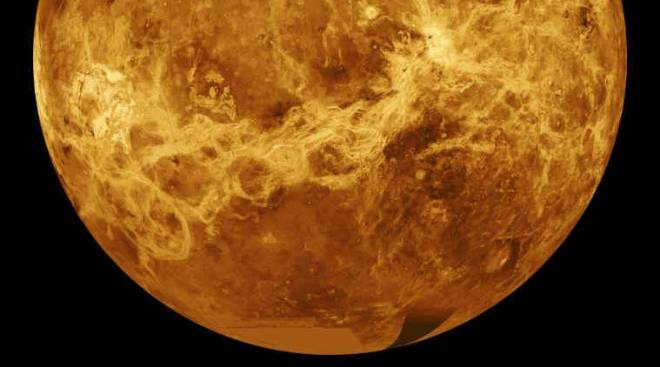New York: Today’s Venus is a hellish world with temperatures reaching 462 degrees Celsius at its surface and almost not water vapour, but for up to two billion years of its early history, the planet could have hosted life, a NASA study says.
In those days, Venus may have had a shallow liquid-water ocean and habitable surface temperatures, according to computer modeling of the planet’s ancient climate by scientists at NASA’s Goddard Institute for Space Studies (GISS) in New York.
The findings, published in the journal Geophysical Research Letters, were obtained with a model similar to the type used to predict future climate change on Earth.
“Many of the same tools we use to model climate change on Earth can be adapted to study climates on other planets, both past and present,” said the paper’s lead author Michael Way, a researcher at GISS.
“These results show ancient Venus may have been a very different place than it is today,” Way noted.
Today’s Venus has a crushing carbon dioxide atmosphere 90 times as thick as Earth’s.
Scientists long have theorised that Venus formed out of ingredients similar to Earth’s, but followed a different evolutionary path.
Measurements by NASA’s Pioneer mission to Venus in the 1980s first suggested Venus originally may have had an ocean.
Previous studies have shown that how fast a planet spins on its axis affects whether it has a habitable climate. A day on Venus is 117 Earth days.
But recent research showed that Venus could have had an atmosphere similar to the Earth’s today.
Another factor that impacts a planet’s climate is topography.
The team postulated ancient Venus had more dry land overall than Earth, especially in the tropics.
That limits the amount of water evaporated from the oceans and, as a result, the greenhouse effect by water vapour.
This type of surface appears ideal for making a planet habitable, according to the scientists.
There seems to have been enough water to support abundant life, with sufficient land to reduce the planet’s sensitivity to changes from incoming sunlight.
The researchers simulated conditions of a hypothetical early Venus with an atmosphere similar to Earth’s, a day as long as Venus’ current day, and a shallow ocean consistent with early data from the Pioneer spacecraft.
The researchers added information about Venus’ topography from radar measurements taken by NASA’s Magellan mission in the 1990s, and filled the lowlands with water, leaving the highlands exposed as Venusian continents.
The study also factored in an ancient sun that was up to 30 percent dimmer.
Even so, ancient Venus still received about 40 per cent more sunlight than Earth does today.
“In the GISS model’s simulation, Venus’ slow spin exposes its dayside to the sun for almost two months at a time,” co-author and fellow GISS scientist Anthony Del Genio said.
“This warms the surface and produces rain that creates a thick layer of clouds, which acts like an umbrella to shield the surface from much of the solar heating. The result is mean climate temperatures that are actually a few degrees cooler than Earth’s today,” Genio said.
IANS

